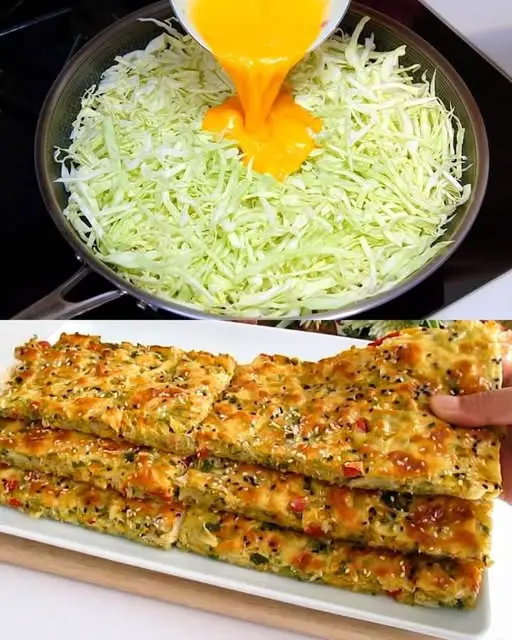Turkish Vegetable Pastry: A Wholesome, Flavorful Dish
Introduction
Turkish Vegetable Pastry is a delightful, savory dish packed with vibrant vegetables, herbs, and a touch of cheese. This recipe is a perfect blend of nutrition and taste, making it ideal for breakfast, brunch, or even as a light dinner. With its crispy edges, tender center, and golden cheese topping, this pastry is a crowd-pleaser that showcases the versatility of vegetables in Turkish cuisine.
Ingredients
Vegetables:
- 1 leek, chopped: Adds a mild onion flavor.
- 300 grams of cabbage, chopped: Provides crunch and sweetness.
- 1 red pepper, chopped: Adds color and a subtle sweetness.
- 2 carrots, chopped: Packed with natural sweetness and vibrant color.
- 2 potatoes, chopped: Brings heartiness to the dish.
Herbs:
- 1 pinch of dill: A classic Turkish herb with a refreshing flavor.
- 1 pinch of parsley: Adds brightness and freshness.
Wet Ingredients:
- 4 eggs: Binds the ingredients and adds richness.
- 4 tablespoons of olive oil (40 ml): For moisture and a healthy fat source.
- 4 tablespoons of milk (40 ml): Enhances the softness of the pastry.
Dry Ingredients:
- 1 teaspoon of salt (8 grams): Enhances flavors.
- 1 teaspoon of black pepper: Adds a touch of spice.
- 4 tablespoons of flour (100 grams): For structure.
- Half a pack of baking soda (5 grams): Helps the pastry rise slightly.
Topping:
- 50 grams of grated Cheddar cheese: Melts beautifully, adding a rich topping.
- Sesame and black cumin seeds: For garnish and an aromatic crunch.
Directions
Step 1: Preheat the Oven
Preheat your oven to 180°C (350°F) and line a large baking tray with greaseproof paper for easy cleanup.
Step 2: Chop the Vegetables
- Chop the leek, cabbage, red pepper, carrots, and potatoes into small, uniform pieces to ensure even cooking.
- Place the chopped vegetables on a large tray.
Step 3: Add Herbs
Sprinkle the chopped vegetables with a pinch of dill and parsley. Mix well to distribute the herbs evenly.
Step 4: Prepare the Sauce
- In a separate mixing bowl, whisk together:
- 4 eggs
- 4 tablespoons of olive oil
- 4 tablespoons of milk
- 1 teaspoon of salt
- 1 teaspoon of black pepper
- Gradually add the flour and baking soda to the mixture, stirring continuously to avoid lumps.
Step 5: Combine the Vegetables and Sauce
Pour the prepared sauce over the vegetables and mix well, ensuring all the vegetables are coated.
Step 6: Spread and Bake
- Spread the vegetable mixture evenly onto the prepared baking tray.
- Place the tray in the preheated oven and bake for 30 minutes.
Step 7: Add Cheese and Garnish
- After 30 minutes, remove the tray from the oven. Sprinkle 50 grams of grated Cheddar cheese over the top.
- Garnish with sesame and black cumin seeds for added flavor and texture.
Step 8: Final Bake
Return the tray to the oven and bake for an additional 15 minutes until the cheese is melted and golden.
Step 9: Cool and Serve
Allow the pastry to cool slightly before slicing. Serve warm for the best flavor and texture.
Serving Suggestions
- Pair with a Side Salad: Fresh greens with a lemon vinaigrette complement the pastry beautifully.
- Add a Sauce: Serve with a dollop of yogurt or tangy tomato sauce for an extra layer of flavor.
- Complete the Meal: Pair with a bowl of lentil or tomato soup for a hearty meal.
Cooking Tips
- Uniform Chopping: Chop all vegetables evenly to ensure they cook at the same rate.
- Seasoning Variations: Experiment with other herbs, such as thyme or mint, for different flavor profiles.
- Gluten-Free Option: Use gluten-free flour to make this recipe suitable for those with gluten sensitivities.
- Dairy-Free Alternative: Omit the cheese or use a plant-based cheese for a dairy-free version.
Nutritional Benefits
- Mixed Vegetables: Provide a variety of vitamins, minerals, and antioxidants.
- Eggs: A great source of protein and essential nutrients.
- Olive Oil: Contains heart-healthy monounsaturated fats.
- Cheddar Cheese: Adds calcium and protein.
Dietary Information
- Vegetarian-Friendly: Suitable for vegetarians.
- Gluten-Free Option: Replace regular flour with gluten-free flour.
- Dairy-Free Option: Use a non-dairy cheese or skip the cheese altogether.
Storage and Reheating
- Refrigeration: Store leftovers in an airtight container in the refrigerator for up to 3 days.
- Freezing: Slice the pastry into portions, wrap them individually, and freeze for up to 2 months. Thaw and reheat before serving.
- Reheating: Warm slices in the oven or microwave until heated through.
FAQs
Can I use other vegetables?
Yes! You can substitute or add vegetables like zucchini, spinach, or mushrooms based on your preference.
How do I make it spicier?
Add a pinch of chili flakes or finely chopped green chilies to the batter for a spicy kick.
Can I prepare this in advance?
Absolutely! Prepare the vegetable mixture and sauce in advance, then assemble and bake when ready.
Why is my pastry too dense?
Ensure you don’t overmix the batter, as this can affect the texture. Also, measure the baking soda accurately.
Can I skip the garnish?
While sesame and black cumin add a nice flavor and texture, you can omit them or replace them with your favorite seeds.
Conclusion
This Turkish Vegetable Pastry is a versatile and nourishing dish that can be enjoyed any time of the day. Packed with colorful vegetables, aromatic herbs, and a cheesy topping, it’s both nutritious and satisfying. Whether served as a main course or a side dish, it’s sure to be a hit with family and friends. Try it today and savor the flavors of Turkish cuisine in every bite! 🌟

